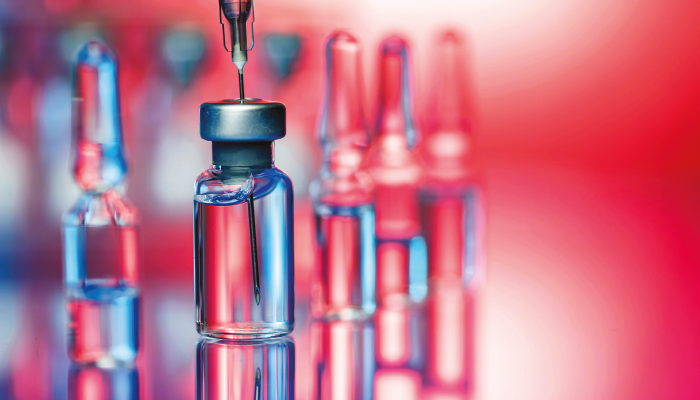There are many factors driving the development of more thermostable vaccines, including the need for cost-effective production, a reduced reliance on cold chains, tighter regulations on animal-based materials, and ensuring return on research investment. A less discussed but equally important aspect is excipients used as stabilizers in vaccine formulations. The type of stabilizers used in viral vaccines largely depends on the vaccine type – particularly the characteristics of the active ingredient or antigen. A mounting body of evidence, however, suggests that gelatin and collagen possess the qualities needed to ensure that vaccines remain potent and effective from production to administration (1, 2).

Copyright: Gregor Schläger
Immunization is one of the biggest success stories and a milestone in global health. Today, vaccines are available to prevent more than 20 life-threatening diseases, allowing people of all ages to live longer, healthier lives. More than just an administration exercise, vaccination is a cornerstone of primary healthcare, a basic human right, and one of the best investments in health. They’re essential to prevent and control outbreaks, they are key to global health security, and a powerful weapon against antimicrobial resistance.
Vaccines typically contain an agent that resembles a disease-causing micro-organism, its toxins or one of its surface proteins. The agent stimulates the body’s immune system to recognize the agent as foreign, destroy it and “remember” it, so that the immune system can more easily recognize and destroy any of these micro-organisms that it later encounters. They also contain other ingredients to keep the vaccine safe and effective.
This article will focus on stabilizers, and how gelatin and its hydrolysate collagen are perfectly suited to this role. The effectiveness of vaccinations relies heavily on their stability. Depending on the type of vaccine, the inclusion of stabilizing agents can be crucial in terms of protecting the functionality of the API and ensuring the efficacy of the delivered dose. Stabilizers prevent degradation reactions from occurring within the vaccine, and prevent the individual components from adhering to and interacting with the walls of the vial. Among others, they comprise sugars (lactose, sucrose), amino acids (glycine), proteins (recombinant human albumin, derived from yeast), lipid nanoparticles (LNPs) (3) and, of course, gelatin.
Stability by production: the lyophilization process
Freeze drying has been used in the life science industries for more than 50 years, starting with the earliest applications in the stabilization of blood plasma. Lyophilizers have evolved from a simple device for vacuum drying at low temperature to an extremely sophisticated, integrated system that combines several processes to ensure that a product is consistently delivered to technical and biological specifications, while also considering economic, safety, and environmental issues (4).
Generally, freeze drying occurs in three steps under vacuum: freezing, primary and secondary drying. The product to be dried is frozen under atmospheric pressure. In an initial main or primary drying phase, water (in the form of ice) is removed by sublimation. In the secondary drying phase, it is removed by desorption. The reduced moisture content improves the stability and shelf-life of the product, but, in some instances, rehydration can further improve those properties.
The fourth step, rehydration, can be implemented after the secondary drying phase. During rehydration, low concentrations of moisture are intermittently added to the chamber until the required moisture content of the product has been reached. The length of the rehydration phase is product- and moisture content-dependent (5).
Stability by ingredient: the benefits of collagen/gelatin
Many of the stabilizers used in live and/or attenuated vaccines are enriched with protein excipients, such as gelatin and human albumin. Gelatin is classified as GRAS (generally recognized as safe) and is known to have an extremely rare incidence of anaphylaxis (one per 2 million cases). As a key component of the lyophilization process, it helps to safeguard vaccines from temperature-related effects.
Indeed, gelatin has a pedigree of application in pharmaceutical applications, as noted in the 2014 paper “Drug Delivery System of a Radio-protective Inclusion Complex” (6). Working with a novel radio-protective drug, 9-phenyl symm octahydroselenoxanthene (POSX), the authors aimed to improve both solubility and defence against radiation during brachy therapy using complexation and encapsulation. POSX is known to be insoluble in water and unstable in atmospheric oxygen.
Complexation with 2-hydroxypropyl beta-cyclodextrin (HPCD) was shown to improve the water solubility – and thus the bioavailability – of the drug, whereas radio-protection of the resulting inclusion complex was achieved by spray drying with both poly D,L-lactic-co-glycolic acid (PLGA) and gelatin. Following a series of in vitro irradiation tests, it was shown that “the final ointment formulation inhibits neoplasm development and provides efficient protection effect against radiation.” Furthermore, during in vivo tests, it was found that the application of 5 mg/kg (calculated as POSX) doses in mice and rats 7 days before irradiation inhibited the development of any tumorous cells and significantly reduced its inflammation effects on healthy tissue. What’s more, the POSX-HPCD complex encapsulated in gelatin showed a faster release rate compared with formulations developed with other capsule matrices. The authors conclude that this novel drug delivery system is highly recommended for brachy therapy when healthy tissue needs to be protected from radiation injuries.
In another paper, “Formulation and Stabilization of Francisella tularensis Live Vaccine Formulation (LVS),” the authors set out to stabilize a “promising vaccine candidate to protect against F. tularensis exposure (7). Despite the drug being “a particularly thermolabile vaccine and difficult to stabilize sufficiently for storage under refrigerated conditions,” progress in the past had been made using a modified freeze-drying method – with sugar-based formulations – called foam drying to create a solid dosage form.
Biopolymers such as gelatin were incorporated to a solution containing F. tularensis to evaluate their ability to stabilize the drug product. The authors note that the inclusion of 5 percent (w/v) gelatin to the base formulation – 30 percent (w/v) trehalose and 25 mM potassium phosphate at pH 8.0 – significantly improved the stability of foam dried F. tularensis stored at 37 °C; the rate constant of degradation was reported to decrease from −3.5 log10/week0.5 to −0.9 log10/week0.5. Furthermore, the inclusion of gelatin decreased the residual water content from 5.2 to 2.5 percent and increased the Tg from 57.6 °C to 99 °C.
The relative effectiveness of the gelatin-containing formulations became clearer upon comparing their storage stability at lower temperatures. In summary, the optimized F. tularensis formulation, which contained trehalose, gelatin and Pluronic F68, remained stable for approximately 1.5 weeks at 37 °C (time required for the vaccine to decrease in potency by 1 log10 colony forming unit) and for 12 weeks at 25 °C. At refrigerator storage conditions (4 °C), stabilized F. tularensis LVS vaccine exhibited no activity loss for at least 12 weeks. This stabilization method uses conventional freeze dryers and pharmaceutically approved stabilizers; as such, it can be implemented at many manufacturing sites for large-scale production of stabilized vaccines. Plus, the improved heat stability of the LVS could mitigate any risk of vaccine potency loss during long-term storage, shipping and distribution.

Credit: iStock - Supplied by Toshe
Copyright: Toshe
Effective excipient
As evidenced by the published research, gelatin and its collagen hydrolysate are presented as ideal vaccine stabilizers because of their unique properties that help to maintain the integrity and effectiveness of vaccines. Critical criteria include the following:
- Thermostability. Gelatin and collagen are highly effective at protecting vaccines from temperature changes, which is key when it comes to keeping vaccines stable during storage and transport, especially in areas with limited access to refrigeration.
- Protein structure protection. These stabilizers help to preserve the structure of the viral antigens or biological active ingredients in vaccines, preventing them from degradation with time. Gelatin forms a protective “gel-like barrier” that shields the vaccine’s active components from environmental stresses such as heat or freeze-thaw cycles.
- Biocompatibility. Gelatin and collagen, being the most abundant protein in animals is therefore biocompatible by nature, meaning they are safe for use in the human body and well tolerated. Their low allergenic potential makes them suitable for use in human and animal vaccine formulations.
- Versatility. They work well with a wide variety of vaccine types and can be tailored to different formulation needs. Whether in liquid form or freeze-dried vaccines, they help maintain a vaccine’s potency throughout its shelf-life.
- Stabilizing effects during freeze-drying. Gelatin is particularly effective at stabilizing vaccines during lyophilization, which is used to prolong vaccine shelf-life and reduce the need for cold chain storage.
- Moisture control. Acting as a hygroscopic agent, gelatin absorbs excess moisture from the vaccine and prevents crystal formation. This efficient moisture control helps to preserve vaccine stability during extended storage periods.
Further benefits include the fact that gelatin is both sustainable and biodegradable: its biodegradable nature aligns with sustainability and safety principles. Plus, it undergoes enzymatic degradation to create harmless by-products within the body, thus ensuring safe use. Finally, when sourced appropriately, gelatin with high levels of purity and a consistent molecular weight ensures reliable antigen stabilization.
Overcoming the threat of endotoxins
In pharmaceutical, medical device, and healthcare environments, endotoxin control of ingredients and production environments is crucial to ensure product safety and patient well-being. If left unchecked, for example, endotoxins – lipopolysaccharides found in the cell wall of Gram-negative bacteria – can trigger severe immune responses and cause tissue inflammation or even septic shock. This is why regulatory bodies enforce strict thresholds for ingredients such as vaccine stabilizers and end products. Of note, it is the responsibility of the legal manufacturer to ensure that end-product limits are met and approved.
Collagen peptides have shown to be safe and effective stabilization excipients in both human and animal vaccines. Already recognized by global vaccine producers, these ingredients are ideal for liquid and lyophilized formulations, serving as an excellent scaffold to stabilize vaccine antigens and other protein-based components.
Collagen peptides and gelatin are considered to be stable ingredients being biocompatible by nature used in a wide range of biomedical applications. With some suppliers now offering versions that comply with US and European pharmacopeial monograph requirements, further research is currently under way to produce completely endotoxin-free products in the future.
Future Perspective: Animal-Free Collagen Stabilizer Through Fermentation
To meet the ongoing needs of food, health, nutrition, cosmetic, pharmaceutical and medical innovators, there is increasing demand for non-animal alternatives to existing products. Animal-free fermentation-derived gelatin offers several game-changing benefits in a wide range of applications, hence in vaccine stabilization (1). For example, if the yeast Komagataella phaffii (also known as Pichia pastoris) is used during the fermentation process, then the resulting product is endotoxin and animal free by design. In fact, a final value of 0 EU/g, which is used as endotoxin unit (8) is theoretically possible depending on downstream processing. All the other positive properties of gelatin/collagen peptides are retained if the product is hydroxylated in a similar way to nature (9). This provides future users with a variety of unique advantages compared with other commercially available solutions.
References
- FMC Cardoso, D Petrovajová, T Horňáková, “Viral vaccine stabilizers: status and trends,” Acta Virol., 61(3), 231-239 (2017). Doi: 10.4149/av_2017_301.
- N Dumpa et al., “Stability of Vaccines,” AAPS PharmSciTech, 20, 42 (2019). Doi: 10.1208/s12249-018-1254-2.
- E Subroto, R Andoyo, R Indiarto, “Solid Lipid Nanoparticles: Review of the Current Research on Encapsulation and Delivery Systems for Active and Antioxidant Compounds,” Antioxidants 2023, 12, 633 (2023). Doi: 10.3390/antiox12030633
- Demaco, “Lyophilization in the pharmaceutical industry.” Available here: https://demaco-cryogenics.com/blog/lyophilization-in-the-pharmaceutical-industry-2/
- A Merivaara et. al., “Preservation of biomaterials and cells by freeze-drying: Change of paradigm,” Journal of Controlled Release, 336, 480-498 (2021). Doi: 10.1016/j.jconrel.2021.06.042.
- LA Heinrich, B Pajazit, R Roziev, “Drug delivery system of a radio-protective inclusion complex,” Advanced Materials Research, 872, 231-236 (2014). Doi:10.4028/www.scientific.net/AMR.872.231.
- S Ohtake et al., “Formulation and stabilization of Francisella tularensis live vaccine strain,” Journal of Pharmaceutical Science, 100(8), 3076-3087 (2011). Doi: 10.1002/jps.22563.
- USP, USP-NF/PF <85> Bacterial Endotoxin Test (2024). Available here: https://doi.usp.org/USPNF/USPNF_M98830_02_01.html
- T. Shantha Raju, “Hydroxylation of Proteins,” Co- and Post-Translational Modifications of Therapeutic Antibodies and Proteins (2019). Available here: https://doi.org/10.1002/9781119053354.ch10




